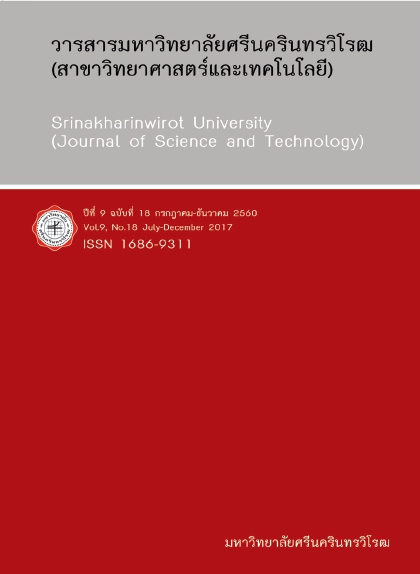กรอบการรับรู้สำหรับประเมินบริการกลุ่มเมฆในหน่วยงานภาครัฐ (A PERCEPTION-BASED FRAMEWORK TO EVALUATE CLOUD SERVICE IN GOVERNMENT AGENCY)
Abstract
An existing evaluation framework of cloud service involved technical complex key criteria and guidelines which were not be standardized. Then the evaluation outcomes of systems and agencies that used cloud services could not be compared. This research had developed the new methodology in evaluating the cloud service so that the outcome could be compared in order to be able to analyzing the value of budgeting and benefits received and to revising the government's cloud service usage policy. The research purposed was to 1) develop a standard perception-based framework to evaluate cloud service in government agency and 2) assess the level of acceptance by the stakeholders. Research tools were 1) a standard perception-based framework to evaluate cloud service in government agency, 2) a questionnaire. The Population was the stakeholders who worked at the information technology center of the government agencies whose mission were different, that were economic, security and social. The sample size was 76 stakeholders. The sampling method used was the stratified random sampling with 25 percent criterion. Statistics used in this research were mean, standard deviation, and One-way ANOVA. The results found that 1) a perception-based framework to evaluate cloud service compose of seven indicators that were achievement, problems solving, acceptance, satisfaction, efficiency, effectiveness, and creativity, 2) The overall acceptance of a perception-based framework by the stakeholder was at high level (X̅ =4.10). The analysis of the difference in level of acceptance of the stakeholders worked in different agencies with different mission using One-way ANOVA found that there was not significantly statistical difference at the level of .05.
Downloads
References
[2] บุญชม ศรีสะอาด. (2554). การวิจัยเบื้องต้น. พิมพ์ครั้งที่ 9. กรุงเทพฯ: สุวีริยาสาส์น.
[3] Al-Maskari, A. (2007). Beyond Classical Measures: How to Evaluate the Effectiveness of the Interactive
Information Retrieval System?. In The SIGIR '07 Proceedings of The 30th Annual International ACM
SIGIR Conference on Research and Development in Information Retrieval, pp. 915-915. New York:
ACM.
[4] Chung, Byung Do; Jeon, Hangoo; & Seo, Kwang-Kyu. (2014). A Framework of Cloud Service Quality
Evaluation System – Focusing on Security Quality Evaluation. In The International Journal of
Software Engineering and Its Applications,V.8. pp. 41-46. Korea: Science and Engineering Research
Support Society.
[5] Clarke, Roger. (2012). A Framework for the Evaluation of CloudSourcing Proposals. In The Bled 25th Bled
eConference 2012: Proceedings of the eDependability : Reliable and Trustworthy eStructures,
eProcesses, eOperations and eServices for the Future. pp. 309-323. Slovenia: Bled eConference.
[6] Fawcett, P. (1999). Managing Information: Understanding the Impact of IT on the Financial Services. Kent:
The Chartered Institute of Bankers.
[7] Garg, Saurabh Kumar; Versteeg, Steve; & Buyya, Rajkumar. (2013). A Framework for ranking of cloud
computing services. In The Future Generation Computer Systems. V.29. pp. 1012-1023. Amsterdam:
Elsevier Science Publishers B.V.
[8] Granneman, Joseph. (2011). A Framework for evaluating cloud computing risk. Chicago:TechTarget.
Retrieved June 9, 2015, from http://searchcloudsecurity. techtarget.com/tip/A-framework-for-
evaluating-cloud-computing-risk.
[9] Holsti, Ole R. (1969). Content Analysis for the Social Sciences and Humanities. London: Addison-Wesley.
[10] Jeon, Hangoo; & Seo, Kwang-Kyu. (2015). A Framework and Improvements of Korea Cloud Services
Certification System. The Scientific World Journal. (2015): 1-12.
[11] Knowledge Impact Strategies. (2013). Evaluation Tools for Adoption of Cloud Hosting Services. Waterloo,
Ontario: Knowledge Impact Strategies Consulting.
[12] Koh, S. C. L., Bayraktar, E., Tatoglu, E., Demirbag, M., & Zaim, S. (2007). Supply Chain and Information
System Services: An Efficiency Comparison between Turkish and Bulgarian SMEs. In The SOLI
2007: Proceedings of The 2007 IEEE International Conference on Service Operations and Logistics,
and Informatics, pp. 1-8. New York: IEEE.
[13] Nokyoongthong, Sira. (2012). การย้ายไปใช้ cloud. สืบค้นเมื่อ 9 มิถุนายน 2058, จาก
http://thaiopensource.org/การย้ายไปใช้-cloud/
[14] NTT Communication. (2011). An Evaluation Framework for Selecting an Enterprise Cloud Provider.
Retrieved June 9, 2015, from https://us.query.ntt.com/en/resources/white-papers/an-evaluation-
framework-for-selecting-an-enterprise-cloud-provider.html
[15] Reixa, Miguel, & Costa, Carlos, & Aparicio, Manuela. (2012). Cloud Services Evaluation Framework. In
OSDOC’12: Proceedings of the Workshop on Open Source and Design of Communication (pp. 61-
69). Lisboa, Portugal: ACM.
[16] Seddon, P. B., & Graeser, V., & Willcocks, L. P. (2002). Measuring Organizational IS Effectiveness: An
Overview and Update of Senior Management Perspectives. SIGMIS Database. (2): 11-28.
[17] Watters, Audrey. (2010). A Community-Based framework to Evaluate Cloud Service Providers. Retrieved
June 9, 2015, from http://readwrite.com/2010/08/28/smi-cloudcommons.
Downloads
Published
How to Cite
Issue
Section
License
Srinakharinwirot University Journal of Sciences and Technology is licensed Under a Creative Commons Attribution-NonCommercial-NoDerivs 4.0 International (CC-BY-NC-ND 4.0) License, Unless Otherwise Stated. Please Read Journal Policies Page for More Information on Open Access, Copyright and Permissions.



